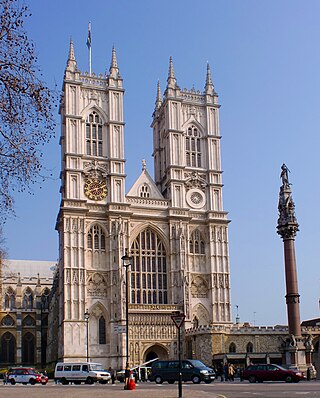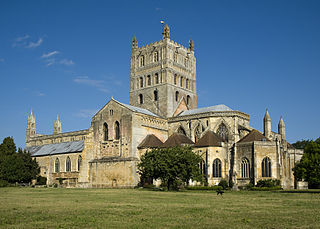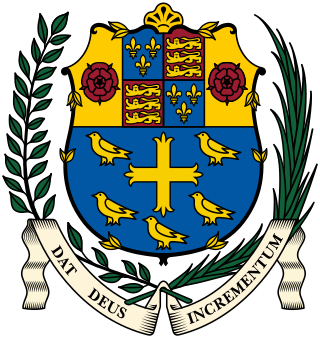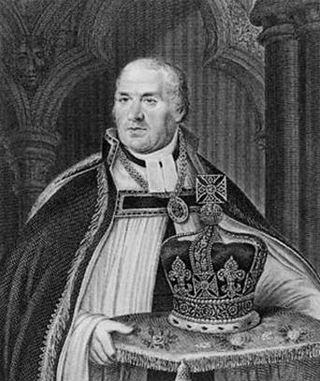Related Research Articles

Westminster Abbey, formally titled the Collegiate Church of Saint Peter at Westminster, is an Anglican church in the City of Westminster, London, England. Since 1066, it has been the location of the coronations of 40 English and British monarchs and a burial site for 18 English, Scottish, and British monarchs. At least 16 royal weddings have taken place at the abbey since 1100.

The Abbey Church of St Mary the Virgin, Tewkesbury, commonly known as Tewkesbury Abbey, is located in the town of Tewkesbury in the ceremonial county of Gloucestershire, England. A former Benedictine monastery, it is now a parish church. Considered one of the finest examples of Norman architecture in Britain, it has "probably the largest and finest Romanesque" crossing tower in England.

Westminster School is a public school in Westminster, London, England, in the precincts of Westminster Abbey. It descends from a charity school founded by Westminster Benedictines before the Norman Conquest, as documented by the Croyland Chronicle and a charter of King Offa. Continuous existence is clear from the early 14th century. Westminster was one of nine schools examined by the 1861 Clarendon Commission and reformed by the Public Schools Act 1868. The school motto, Dat Deus Incrementum, quotes 1 Corinthians 3:6: "I planted the seed... but God made it grow." The school owns playing fields and tennis courts in the centre of the 13-acre Vincent Square, along which Westminster Under School is also situated.

John Feckenham O.S.B., also known as John Howman of Feckingham and later John de Feckenham or John Fecknam, was an English churchman, the last abbot of Westminster.

Glastonbury Abbey was a monastery in Glastonbury, Somerset, England. Its ruins, a grade I listed building and scheduled ancient monument, are open as a visitor attraction.

The Church of St Margaret, Westminster Abbey is in the grounds of Westminster Abbey on Parliament Square, London, England. It is dedicated to Margaret of Antioch, and forms part of a single World Heritage Site with the Palace of Westminster and Westminster Abbey.

Westminster Abbey is a community of Benedictine monks in Mission, British Columbia, established in 1939 from the Abbey of Mount Angel, Oregon. The abbey is home to the Seminary of Christ the King and is a member of the Swiss American Congregation within the Benedictine Confederation.
The Master of the Jewel Office was a position in the Royal Households of England, the Kingdom of Great Britain and the United Kingdom. The office holder was responsible for running the Jewel House, which houses the Crown Jewels. This role has, at various points in history, been called Master or Treasurer of the Jewel House, Master or Keeper of the Crown Jewels, Master or Keeper of the Regalia, and Keeper of the Jewel House. In 1967, the role was combined with Resident Governor of the Tower of London.

The Diocese of Westminster was a short-lived diocese of the Church of England, extant from 1540 to 1550. Westminster Abbey served as its cathedral.

The Dean of Westminster is the head of the chapter at Westminster Abbey. Due to the abbey's status as a royal peculiar, the dean answers directly to the British monarch. Initially, the office was a successor to that of Abbot of Westminster, and was for the first 10 years cathedral dean for the Diocese of Westminster. The current dean is David Hoyle.
John Flete was an English monk and ecclesiastical historian who documented the history and abbots of Westminster Abbey.

William Vincent was Dean of Westminster from 1802 to 1815.
John Islip (1464–1532) was abbot of the monastery of Westminster, London, in Tudor times.

Joseph Armitage Robinson was a priest in the Church of England and scholar. He was successively Dean of Westminster (1902–1911) and of Wells (1911–1933).
Sulcard was a Benedictine monk at St. Peter's, Westminster Abbey, and the author of the first history of the abbey.

John Ireland was an English Anglican priest, who served as Dean of Westminster from 1816 until his death. In this role, he carried the crown during the coronation services at Westminster Abbey of two monarchs. Theologically and politically conservative, as shown in his writings, he was generous with the considerable riches that he acquired during his career, making large donations to support education and relieve poverty in his home town. In 1831, as Ireland was "a distinguished Benefactor of the University", Oxford had sought and obtained his permission to put on display a marble bust of him by the sculptor Sir Francis Leggatt Chantrey. The bust is now in the Examination Schools of the university. During his lifetime, he established scholarships at the University of Oxford, and in his will, he left money to establish the post of Dean Ireland's Professor of the Exegesis of Holy Scripture.
The Archdeacon of Westminster is a senior ecclesiastical officer within the Chapter of the Royal Peculiar of Westminster Abbey in London. The holder of the post oversees relationships with the twenty-four parishes of which the Dean and Chapter are patrons, and is responsible for the pastoral care of the staff and volunteers of the Abbey.
Richard of Ware was the abbot of Westminster Abbey from 1258 to 1283.
Vitalis of Creuilly or Vitalis of Bernay was a Benedictine monk from Normandy. Sources on his life include the early 15th century history of the Abbey by John Flete and the 1751 An history of the Church of St. Peter, Westminster, commonly called Westminster Abbey by Richard Widmore.
William de Haseley was an English monastic writer. He was sub-prior of the Benedictine community at Westminster Abbey and master of the novices. He entered the monastery in about 1266 and compiled the Consuetudinarium Monachorum Westmonasteriensium for his abbot, Richard de la Ware.
References
- 1 2 3 Smith, Emily Tennyson (Bradley); Micklethwaite, John Thomas (1898). Annals of Westminster abbey. Robarts - University of Toronto. London Cassell.
- 1 2 3 4 5 6 7 8 9 10 11 12 13 14 15 16 17 18 19 20 21 22 23 24 25 26 27 28 29 30 31 32 33 34 35 36 37 Flete, John; Robinson, J. Armitage (Joseph Armitage) (2005) [1443 (original work by John Flete)]. Harvey, Barbara F. (ed.). The History of Westminster Abbey. Oxford University Press. ISBN 9781120035516.
- ↑ pixeltocode.uk, PixelToCode. "Abbots & Deans". Westminster Abbey. Retrieved 2 October 2024.
- ↑ "Bishop, Abbots and Deans of Westminster". www.tudorplace.com.ar. Retrieved 2 October 2024.